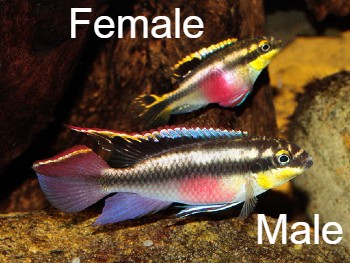Affiliate Disclaimer:
FishKeepingAnswers.com is reader-supported. When you buy through links on our site we may earn a commission.
When preparing to breed or trying to attract a mate, Kribensis may ‘shake’, ‘dance’ or ‘flash’ at one another. This shaking takes place in front of a chosen spawning site. Both sexes take part in this mating ritual which usually happens before the pair enter a cave to spawn.
Kribensis Breeding Behavior
Kribensis often go through a mating ritual prior to spawning. One or both sexes will dance in front of their chosen spawning site to entice the other to come into the cave.
If the female is trying to attract the male to her cave, she will turn sideways in front of him, showing off her bright red belly. She will bend herself into an ‘L’ shape in front of him and she may shimmer on the spot.
Both sexes may enter and then leave the cave several times prior to spawning taking place. They may well bring out a mouthful of substrate each time, spitting it in front of the cave, sometimes trying to make the cave entrance smaller to keep other fish out.
Spawning will take place inside the cave where the female will remain until the fry have hatched and are free-swimming. Male Kribensis will defend their chosen spawning site fiercely and he will spend all his time chasing away any other fish that stray too close to the cave.
How Do You Sex Kribensis?
Kribensis are one of the easiest members of the Cichlid family to sex. Males tend to be larger and slimmer than females. The male’s dorsal fin is also more elongated and extends down to a point, whereas the female’s dorsal fin is more rounded. Females are plumper than males and they have a bright red belly, especially when preparing to spawn.

In this photo, the female is above the male. You can clearly see the cherry pink color of her belly. The male’s dorsal fin is also clearly more pointed than the females.
How Do You Know If Your Kribensis Are Spawning?
Kribensis are secretive spawners. They spawn exclusively in caves away from prying eyes.
Unless you observe the pre-spawning mating ritual, the first you may know of the spawning is when the parents bring their fry out into the open aquarium for the first time.
There are signs you can look out for if you think your Kribensis may have spawned
- There is a pile of substrate at the entrance to the cave, reducing the size of the opening of the cave.
- You haven’t seen your female for 7 to 10 days (as she will be in the cave tending to the eggs)
- The male is stationed in front of the cave, chasing off all those who stray to close
Breeders Tip:
The secret to successfully breeding fish is feeding a quality diet. Check out this food on Amazon.com, I can’t recommend it enough!
How Often Do Kribensis Breed?
Kribensis pair for life and are devoted parents. They will raise their fry together until they are old enough to live freely in the aquarium. After 4 to 6 weeks the parents will be ready to spawn again. At this stage, the first brood of fry should be removed from the aquarium as the parents may see them as a threat to the next batch of eggs.
Can You Stop Kribensis Breeding?
If you have both a male and female Kribensis in the same tank, there is a good chance they will pair up and spawn. If you don’t want to be overrun with Kribensis babies, there are one or two tricks you can use to stop them from spawning.
- Make sure there are no caves – Remove decorations from the aquarium which could be used as a cave. This includes upturned flower pots, pieces of bogwood and rocks the Kribensis could burrow under. Kribensis are hardcore cave spawners. Without a suitable cave they won’t spawn.
- Reduce the tank temperature – Kribensis like to spawn when the water temperature is in the high 70°F or even low 80°F. By lowering the temperature to around 75°F you reduce the Kribensis inclination to spawn.
- Keep a single Kribensis – Kribensis are quite happy living without a mate. Keep just one male in the tank and you still won’t be disappointed by his rainbow coloration.
Why not check out my articles Why do Kribensis Eat Their Babies? or What Other Fish Can Live With Kribensis?





